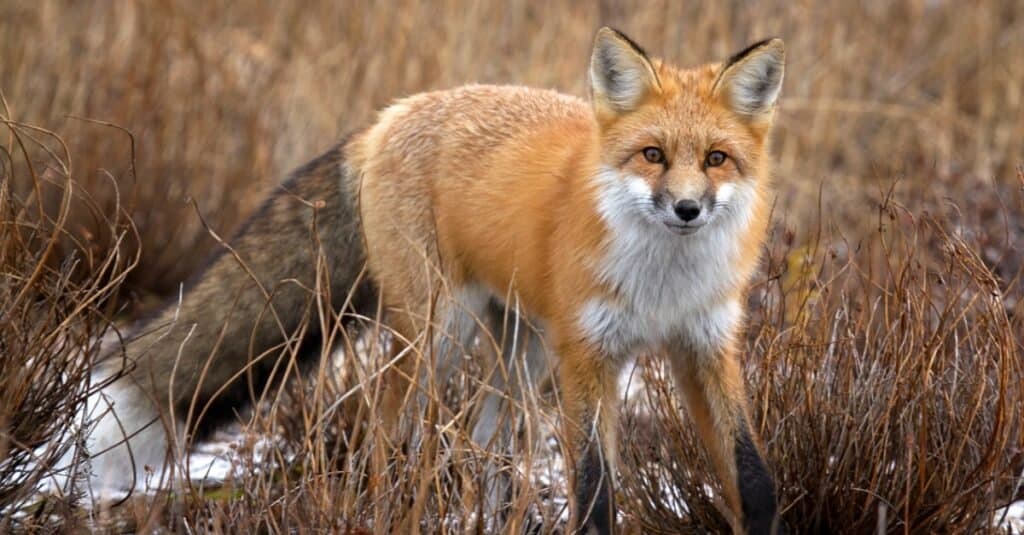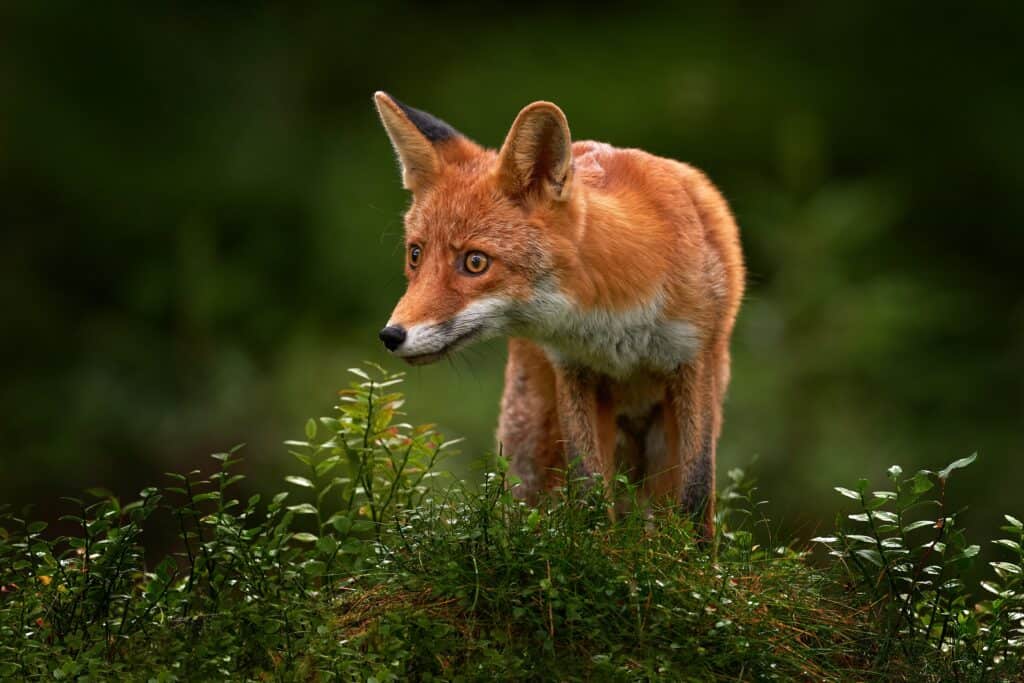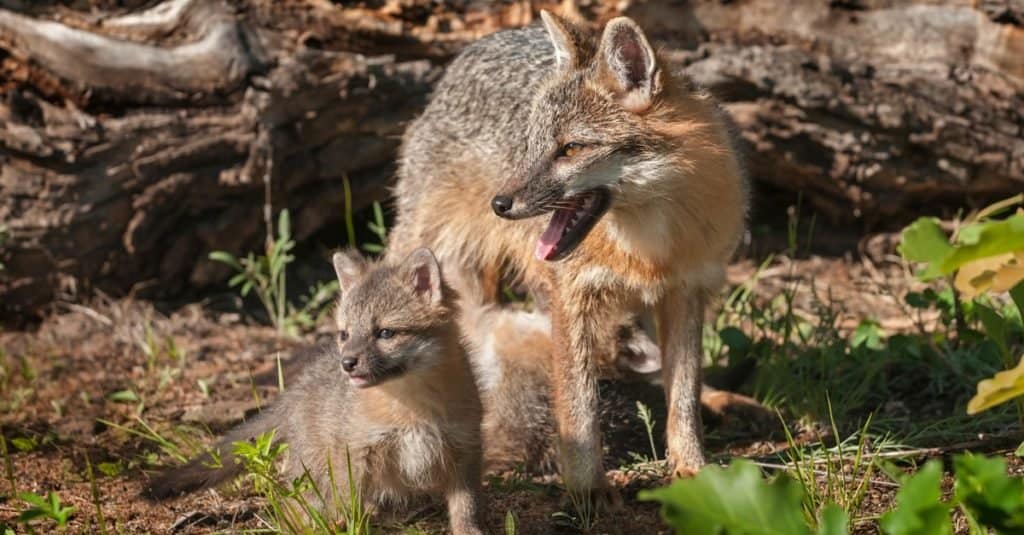Foxes are a favorite subject in popular folklore, often described as sly and cunny antagonists. These wild animals are known for their fur and resemble dogs. These small to medium-sized canines can be found in almost every continent, including states in North America, such as Michigan.
Michigan is an Upper Midwestern state in the Great Lakes region of the United States of America and is home to several forest-dwelling animals, such as foxes. Some of these foxes can be encountered in urban areas of the state. If you reside in Michigan or plan to take a trip there, it is important to know the different types of foxes you may come across in the state.
The Types of Foxes in Michigan
There are about four types of foxes in North America, but only two are native to the State of Michigan: the gray fox and the red fox.
1. Gray Fox (Urocyon cinereoargenteus)

Gray foxes are the only fox species that span North and South America.
©iStock.com/johnpane
Gray foxes are the only fox species that span both North and South America. They range from southern Canada through the southern regions of North America, to Colombia and Venezuela in South America. Scientists believe these foxes have been in North America since the Mid-Pliocene Period, over 3.5 million years ago, with the first fossil found in Arizona.
With a maximum length of 44 inches and a weight of 15 pounds, gray foxes are easily one of the largest foxes worldwide, about the size of a large domestic cat. The scientific name for gray foxes is Urocyon cinereoargenteus. Cinereoargenteus means silver or ashen, which clearly describes the gray fox’s most common fur color. They can also be seen in red. They have thick furry tails, pointy snouts, angled ears, and black colors around their eyes, nose, and eyes.
Gray foxes are omnivores and opportunistic hunters. These nocturnal animals rely on their top speed of 28mph, agility, and keen senses to catch prey. They sneak up on mammals smaller than them, such as shrews and birds, or any small prey or carcass available in their habitats. Their penchant for tree-climbing helps them collect fruits, nuts, and vegetable matter, which they sometimes store in their dens.
These wild animals prefer to reside in woodlands, canyons, deserts, and forests. They make their dens in trees, hollow stumps, or any cavity they can find and stay in groups as small family units. Gray foxes have recently been found around human settlements, with reports suggesting that the habitat shift is due to predation and lack of prey (due to deforestation). Gray foxes have an average gestation period of 53 days and birth an average of four kits, which are often targeted by predators.
2. Red Fox (Vulpes vulpes)

Red foxes are the largest and most widely distributed fox species worldwide.
©iStock.com/Lynn_Bystrom
According to the Guinness World Records, the red fox is the largest and most widely spread fox species worldwide. They can be found in North America, Europe, Africa, and Asia and have been successfully introduced to countries like Australia. Adult red foxes can grow as tall as 20 inches at shoulder height, have body lengths of about three feet, and can weigh up to 31 pounds.
These large foxes are mostly known for their reddish-orange fur, which is highly coveted by fur traders. Other distinctive features of the red fox include their long and pointy snouts, large pointy ears, black feet, white or gray-furred chest, and thickly furred tails, which can be up to one-third their body length. In winter, their tails help cover body areas with less fur, such as their nose and the bottoms of their limbs.
Like other foxes, red foxes are omnivores, and their diet ranges from small mammals like rodents, rabbits, and livestock to fruits, insects, plants, and anything they can find in garbage bins. Given their robust diet range and adaptive nature, red foxes can be found in diverse habitats, but they prefer woodlands near open areas.
Red foxes mate in the winter and can have up to a dozen litter in the spring. The kits are born brown and do not turn red-furred until after a month. Though these foxes are regarded as North American natives, scientists debate whether these foxes had always been on the continent or they were introduced by Europeans.
Red Foxes Can Be Gray: How to Distinguish Between These Foxes

Red foxes are larger than gray foxes and have white-tipped tails.
©Ondrej Prosicky/Shutterstock.com
While the color-distinctive names of the two Michigan fox species set them apart, it can still prove shockingly difficult to tell them apart from one another as they can look similar. Red foxes can also be gray, brown, or black. So how do you tell a red fox apart from a gray fox?
According to the Huron-Clinton Metro Park, a similarity among all red foxes is that their tails end in white fur, while gray foxes’ tails end in black fur. Red foxes also have black feet, which gray foxes do not have.
Another means of telling the fox species apart is the shape of their faces. Red foxes have pointier faces, while gray foxes have almost catlike faces. Usually, red foxes grow to larger sizes than their gray cousins and do not share the gray foxes’ penchant for climbing trees.
Where Can Foxes Be Found in Michigan?

Gray and red foxes can be found in every county in Michigan.
©Holly Kuchera/Shutterstock.com
Foxes are quite adaptable and live in diverse environments, including urban and semi-urban areas. The naturally occurring fox habitats are the Arctic and alpine tundra, deserts, mountains, plateaus, woodlands, grasslands, and forests.
According to the Department of Natural Resources, red and gray fox species can be found in all 83 counties in Michigan. Red foxes are more common in urban and semi-urban areas than gray foxes, increasing their popularity. This is due to the higher adaptability of red foxes to new environments. According to the North Carolina State University, some reasons foxes are found close to human-populated areas include the loss of natural habitats and the increased coyote population in North America. Coyotes were more prominent in the western states of America. However, the absence of larger predators, such as wolves and cougars, has allowed them to move into western states, forcing foxes to stay closer to urban areas where coyotes would not venture.
Bonus: Do Foxes Prey on Pets?

Red foxes are adapting to living in close proximity to humans.
©bardzo.photo/Shutterstock.com
While the gray fox remains elusive, red foxes are seen more frequently these days as their range extends into urban areas. That raises the question of whether these dog-like animals have added our pets to their menus. The short answer is – foxes have been know to attack little dogs and cats – but not very often. Chickens, on the other hand – are a favorite of the cunning canines and require special fencing around the coop.
Unlike coyotes, which hunt in packs and are definitely a threat to pets – foxes focus on small animals like mice and are more of a threat to your neat yard when they invade your garbage. Gray foxes have jumped down from trees to attack small dogs when people are camping or invading their territory – but they seldom inhabit areas populated by people like red foxes do.
You can ensure the safety of your pets by walking outside with your dog when it goes out – foxes won’t launch an attack if you are near – and by avoiding the practice of de-clawing your cats. Cats are pretty good at defending themselves against foxes – so don’t disarm them of their natural weapons.
The photo featured at the top of this post is © iStock.com/RT-Images
Thank you for reading! Have some feedback for us? Contact the AZ Animals editorial team.






